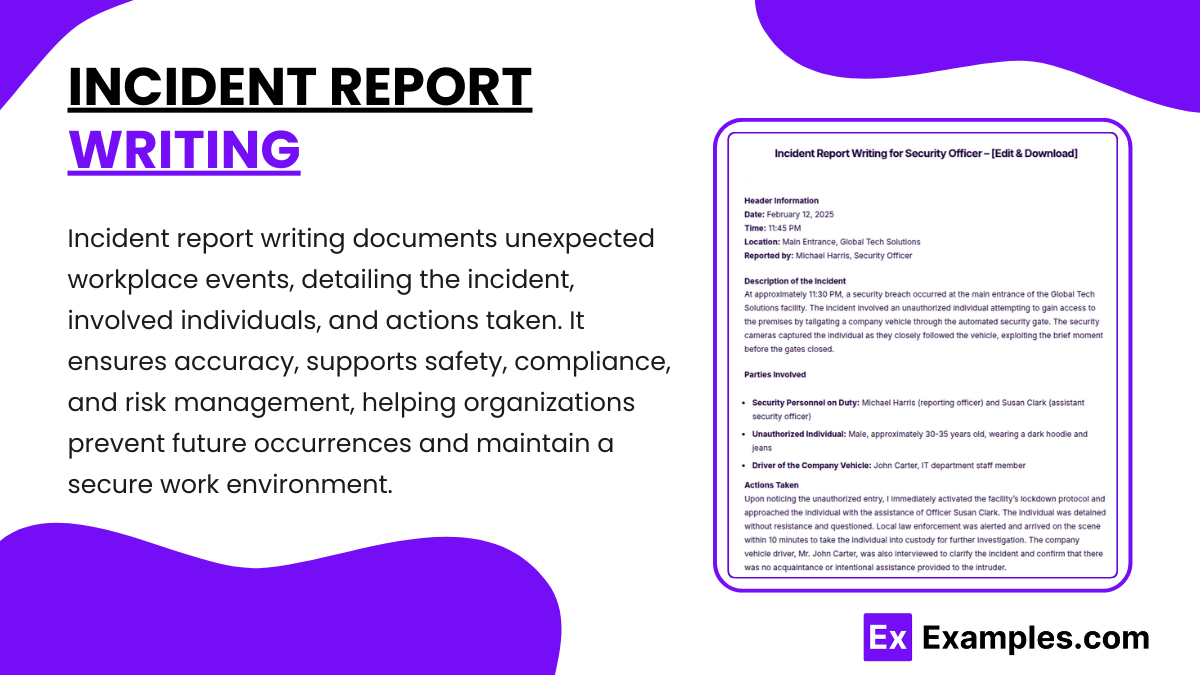15+ Incident Report Writing Examples to Download
Incident report writing is a crucial process used in various industries to document any unusual or unexpected events that occur at the workplace. It involves a clear and concise description of what happened, including the details of the incident, the people involved, and the actions taken afterward. The goal of an incident report is to record the facts accurately and provide insights that can help prevent future occurrences. Whether it’s for maintaining safety, improving operations, or complying with legal requirements, effective incident report writing ensures that all significant incidents are noted in a systematic way, enabling organizations to manage risks more effectively and maintain a safer work environment.
What is Incident Report Writing?
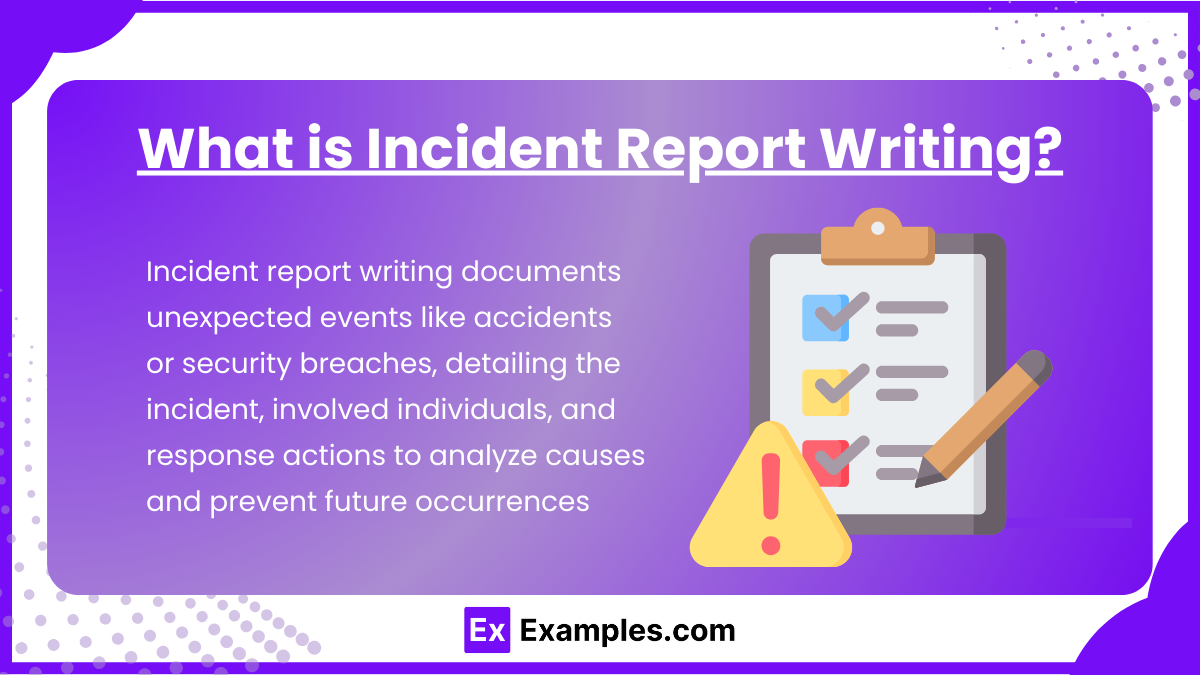
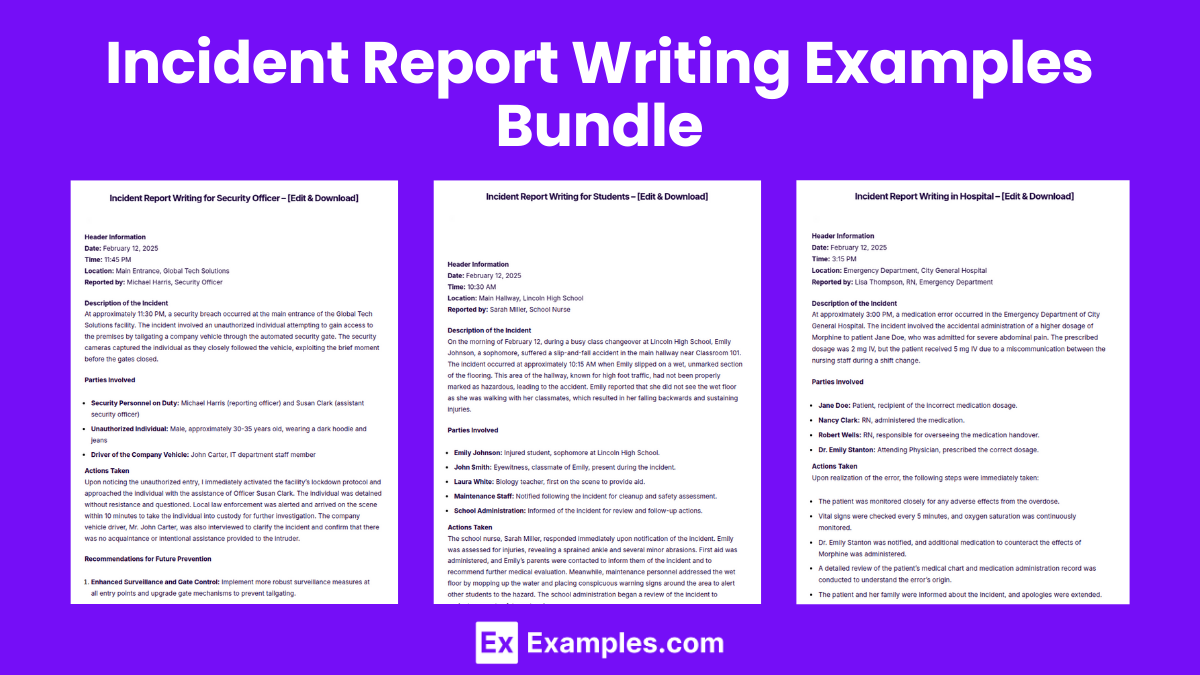
Incident Report Writing Examples Bundle
Incident Report Writing Format
Header Information
Include essential details such as the date, time, and location of the incident, along with the reporter’s name and position.
Description of the Incident
Provide a factual and detailed account of what occurred, specifying the sequence of events and any immediate actions taken.
Parties Involved
Document the names and roles of all individuals involved, including any witnesses.
Actions Taken
Describe the steps taken immediately after the incident to manage the situation.
Recommendations for Future Prevention
Offer suggestions for procedural changes or improvements to prevent future occurrences.
Attachments
Attach any relevant supporting documents, photos, or additional evidence related to the incident.
Incident Report Writing Example
Date: January 15, 2025
Time: 2:00 PM
Location: Warehouse A, Company XYZ
Reported by: John Doe, Safety Officer
During routine operations at Warehouse A, a forklift operated by Employee #1 collided with a storage rack at approximately 1:45 PM. The collision caused several items to fall from the rack, though fortunately, no injuries were reported. The forklift driver stated that he swerved to avoid a puddle of water on the floor, which he had not noticed earlier.
Employee #1: Forklift Operator (Driver at the time of the incident)
Employee #2: Witness, working adjacent to the incident area
Immediately after the incident, the area was cordoned off, and the spilled items were cleaned up to prevent further accidents. The forklift was checked for damage and temporarily taken out of service for a full safety inspection.
Regular inspections to identify and rectify potential hazards like water spills.
Enhanced training for all forklift operators to handle unexpected obstacles.
Installation of more visible signage around potential hazard areas.
Photographs of the incident scene
Safety inspection report of the forklift
Statements from Employee #1 and Employee #2
Incident Report Writing Examples
Incident Report Writing for Students
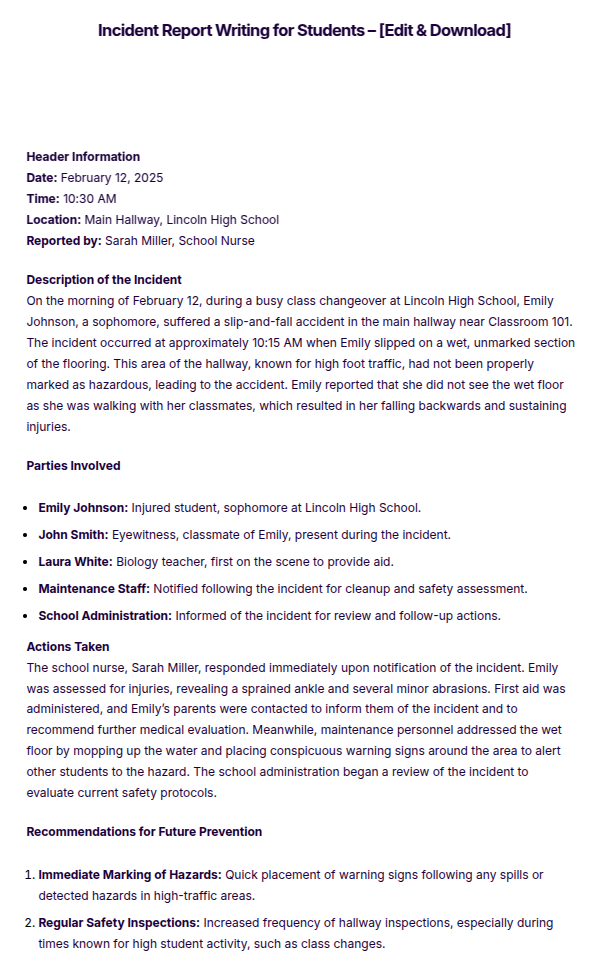
Incident Report Writing for Security Officer
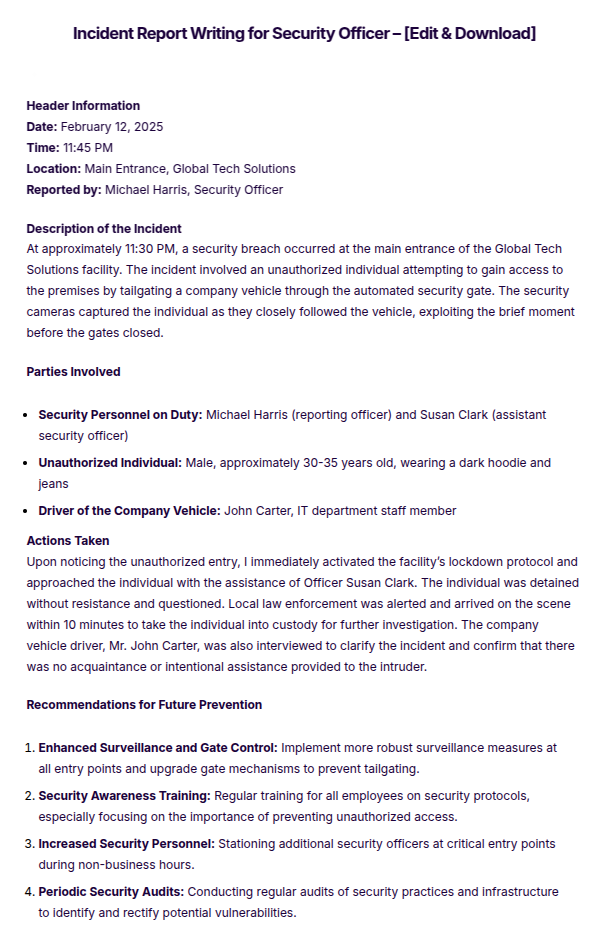
Incident Report Writing in Hospital
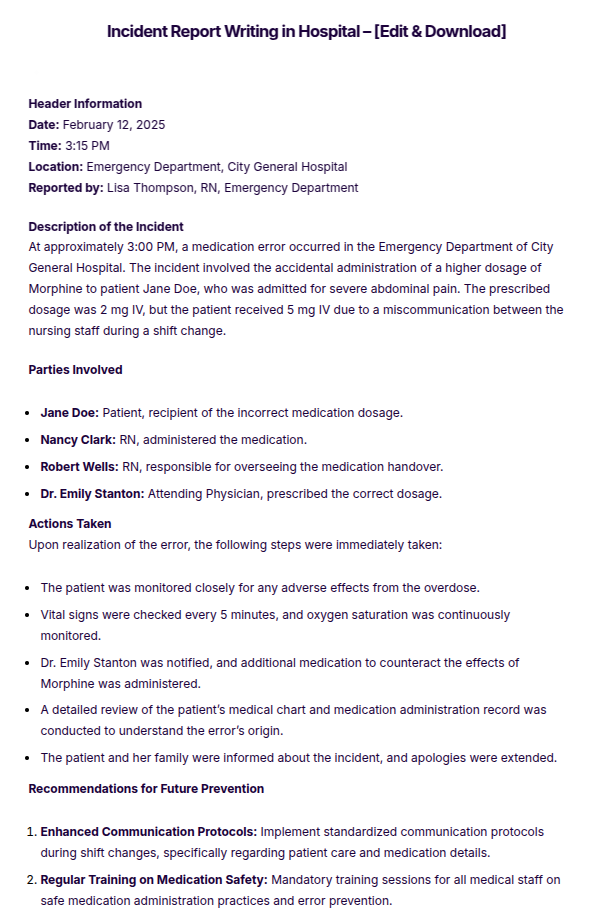
More Examples on Incident Report Writing
- Incident Report Writing in Nursing
- Fire Incident Report Writing
- childcare Incident Report Writing
- Security Incident Report Writing
- Police Incident Report Writing
- Drowning Incident Report Writing
- Proper Incident Report Writing
Incident Report Template
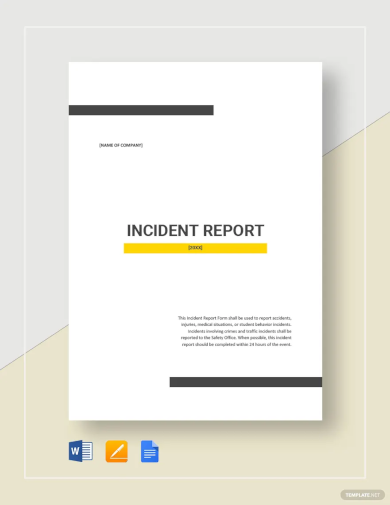
Incident Report Form Template
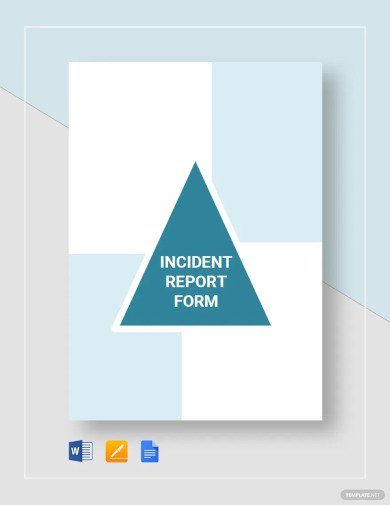
Incident Investigation Report Example
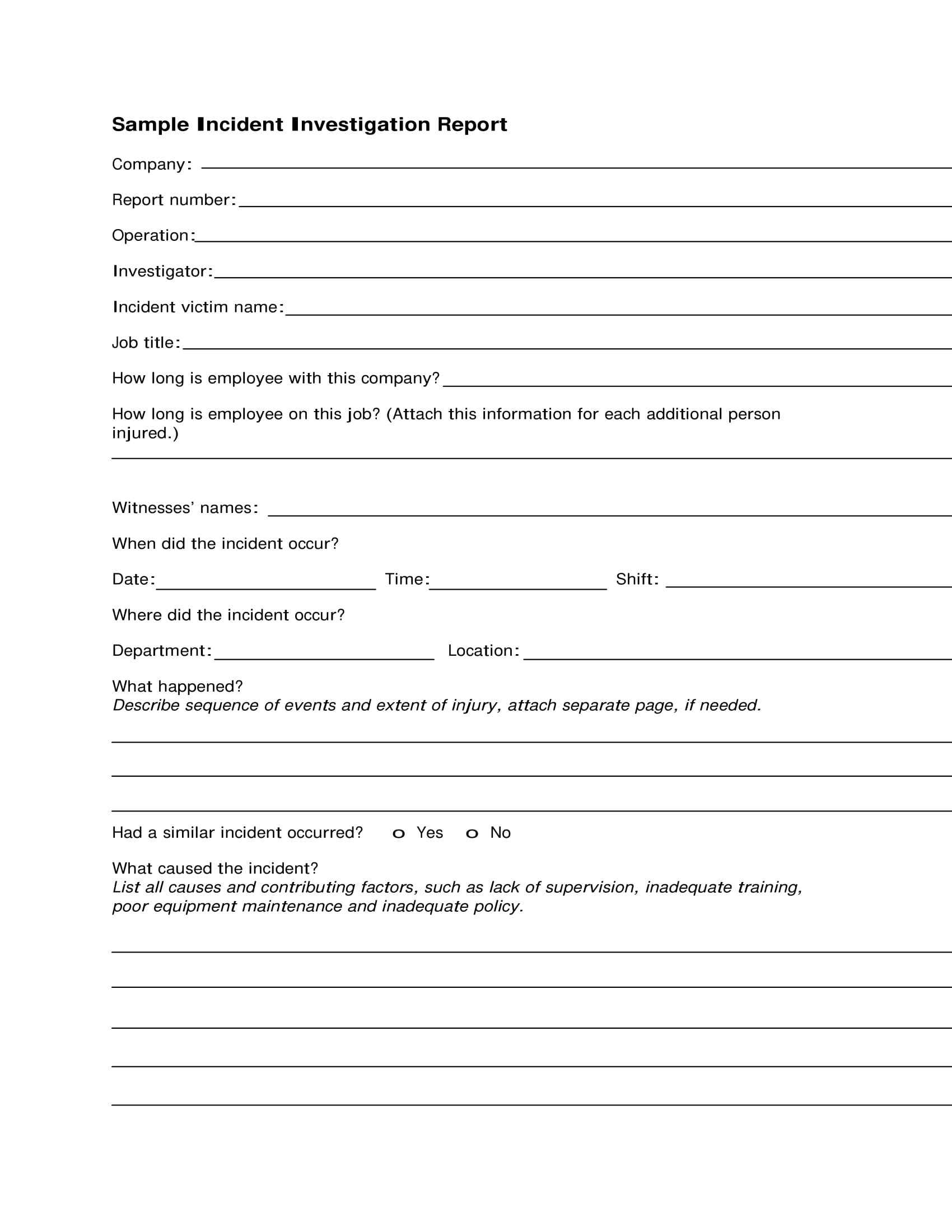
Incident Report Sheet Example
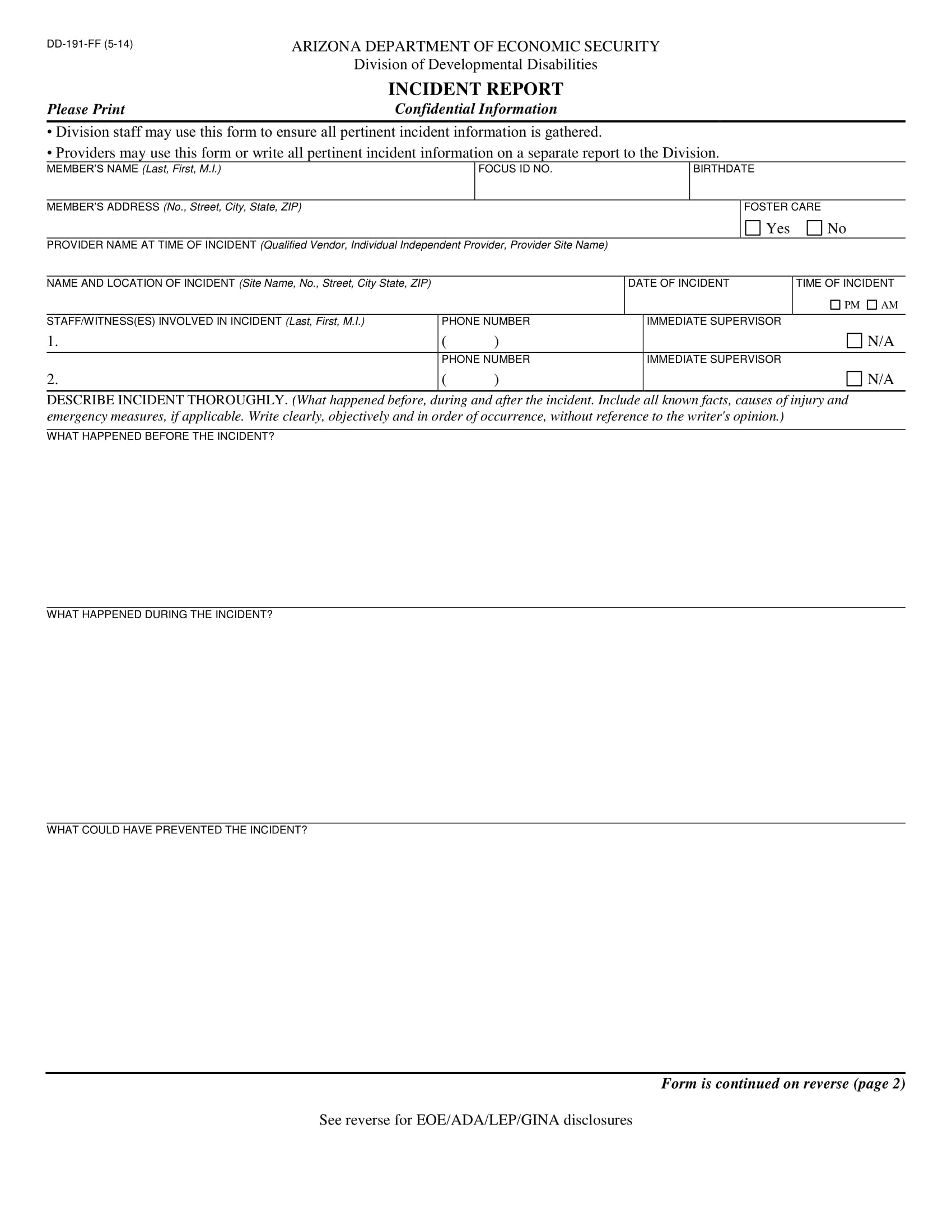
Accident or Incident Report Form Example
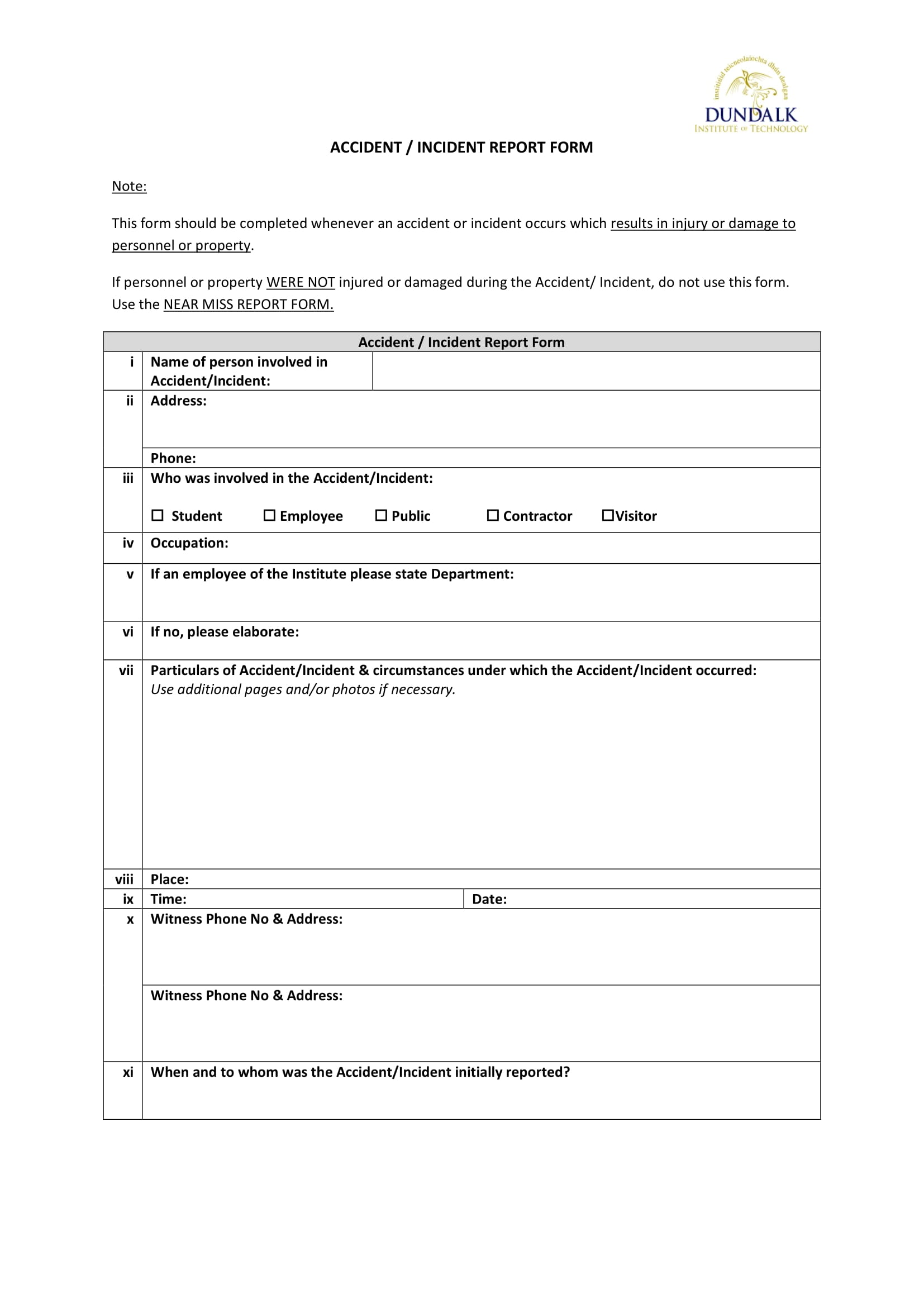
Incident Report Example
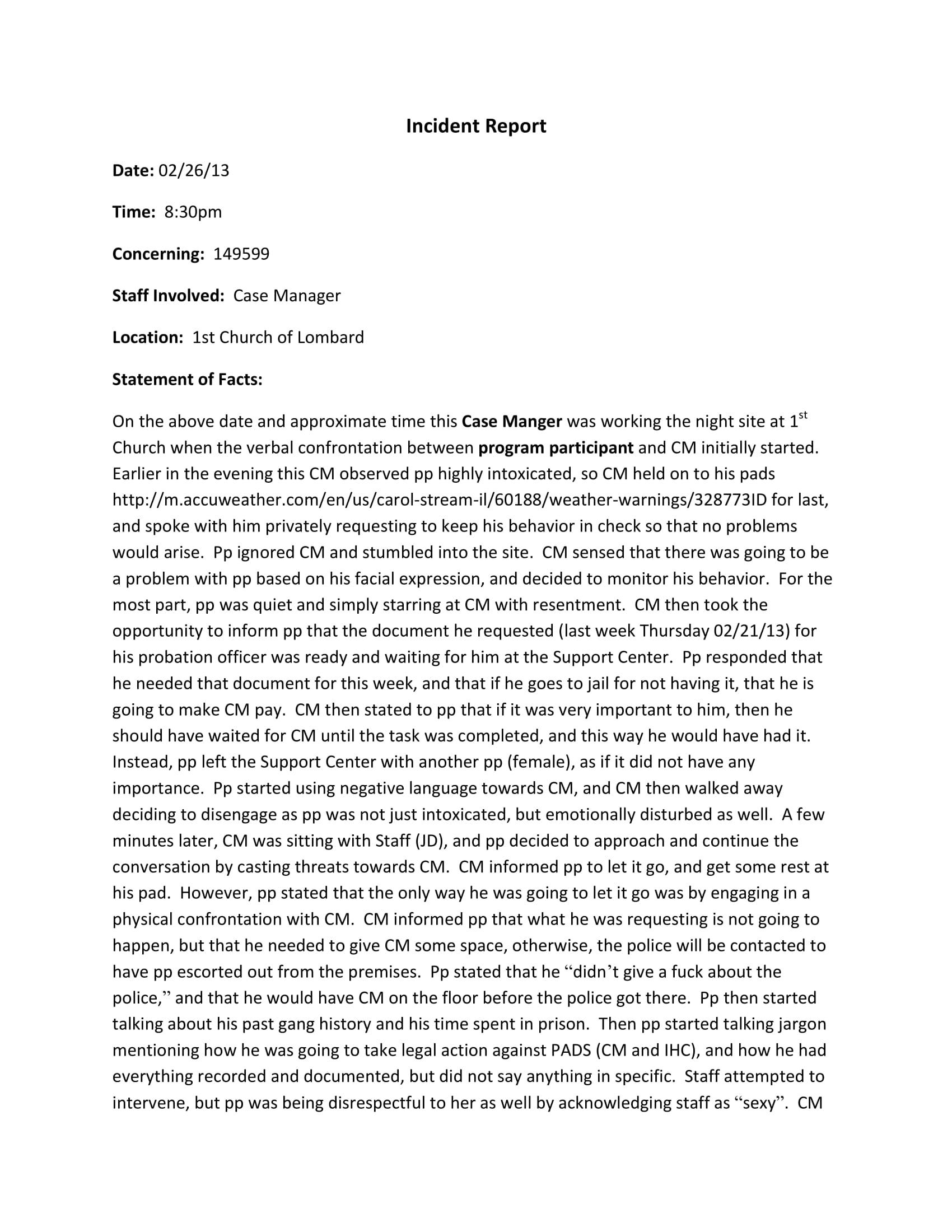
Five Rules of Incident Report Writing
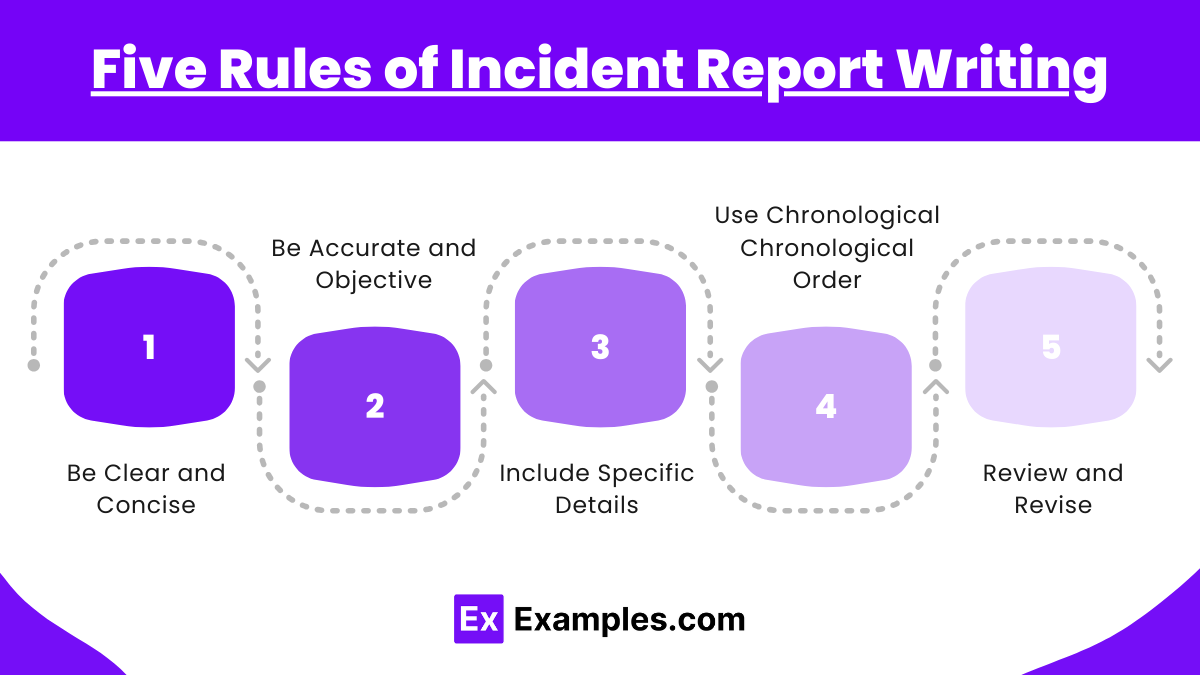
1. Be Clear and Concise
Ensure that the language used in the report is straightforward and direct. Avoid using jargon or overly technical terms that might confuse the reader. The report should communicate the facts of the incident clearly and succinctly, focusing on who, what, when, where, and how.
2. Be Accurate and Objective
The report must accurately reflect what happened, based solely on facts. Avoid making assumptions or including subjective opinions. If eyewitness accounts vary, note the discrepancies clearly. Accuracy also includes spelling, grammar, and ensuring that all names and terms are spelled correctly.
3. Include Specific Details
Provide all necessary details that could impact the understanding of the incident. This includes exact times, dates, locations, and the identities of any witnesses or parties involved. Descriptions should be detailed enough to provide a complete picture of the incident without being unnecessarily lengthy.
4. Use Chronological Chronological Order
Organize the information in the order in which it happened. This helps to establish a clear sequence of events and makes the report easier to follow. Start from the initial moments leading up to the incident and proceed through to the final outcomes and actions taken.
5. Review and Revise
After writing the initial draft, review the report to ensure that it is free from errors and omissions. It may be helpful to have another person review it as well, particularly someone who has experience with incident reports or who may have witnessed the incident. This can help ensure the report is as accurate and complete as possible.
How to Write a Incident Report
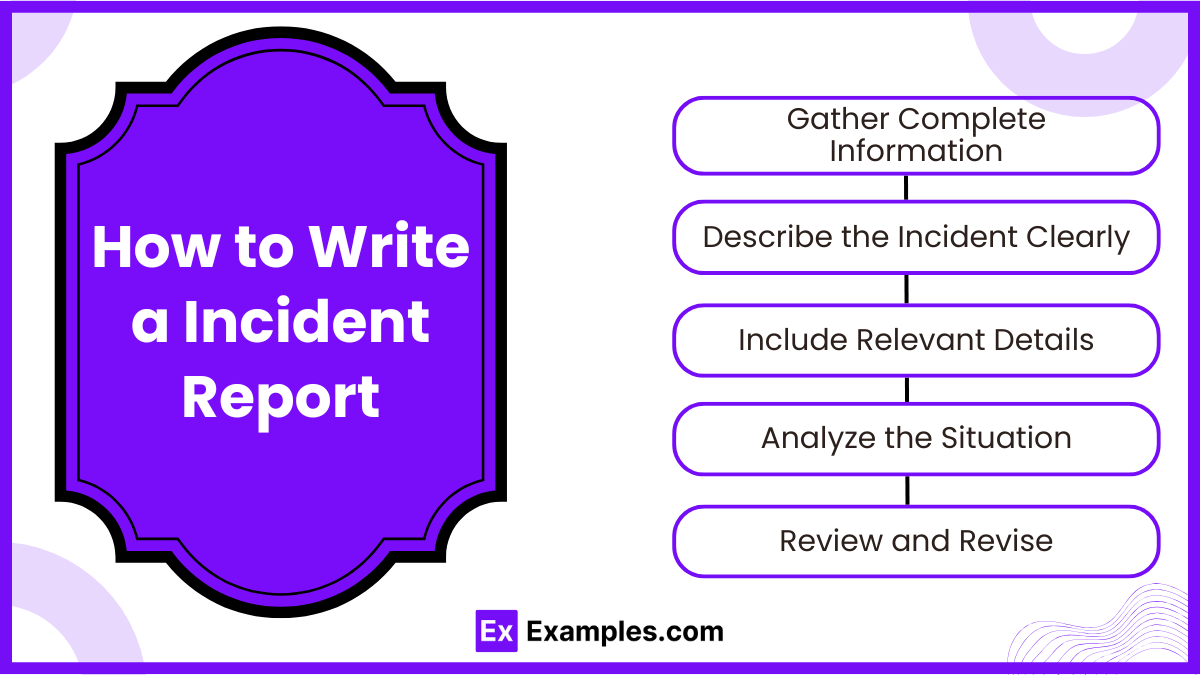
Gather Complete Information
Start by collecting all the facts related to the incident, including the date, time, and specific location of the event. Record the names and contact information of any witnesses and a detailed account of what happened from all parties involved.
Describe the Incident Clearly
Write a factual description of the incident in a clear and concise manner. Use simple language and ensure that the sequence of events is described chronologically. Include specific details like actions taken by the individuals involved and any immediate outcomes.
Include Relevant Details
Make sure to note any physical injuries, property damage, or potential policy violations. Attach or reference any physical evidence, such as photos, videos, or objects related to the incident.
Analyze the Situation
While the main focus should be on the facts, adding a section for an analysis can be helpful. This part should discuss potential causes of the incident and any steps taken to resolve the situation or mitigate future risks.
Review and Revise
Once the report is written, review it for accuracy and completeness. Check for any grammatical errors, and ensure the report maintains an objective tone throughout. It may be beneficial to have another person review the report to confirm it is clear and all necessary details have been included.
Guidelines for Writing and Developing Incident Reports
- Start with Immediate Facts: Open the report by listing the basic but crucial facts including the date, time, location, and specific type of incident. This sets a clear context for whoever reads the report.
- Use a Clear and Objective Tone: Maintain an objective tone throughout the report. Avoid using subjective language, personal opinions, or assumptions. Your goal is to provide a factual, unbiased account of the incident.
- Detail the Incident Chronologically: Describe the events in the order they occurred. This chronological detailing helps in understanding the sequence of events and can be crucial for investigations. Include specific actions, conversations, and decisions that were made related to the incident.
- Include Comprehensive Information: Cover all aspects of the incident, including:
- Parties involved: List everyone involved and their roles or involvement in the incident.
- Witness accounts: Include statements or observations from witnesses. Document their names and contact information.
- Injuries or damages: Note any injuries to persons or damage to property or equipment.
- Immediate actions taken: Describe what actions were taken immediately after the incident, such as calling emergency services, first aid administered, or safety measures implemented.
- Recommendations for Future Prevention: Based on the incident, suggest actionable steps or improvements to prevent future occurrences. This might include changes to procedures, training needs, or enhancements in equipment or facilities.
- Review and Finalize the Report: After drafting the report, review it to ensure all information is complete, accurate, and presented clearly. Check for grammatical errors or ambiguous language that could confuse the reader. It’s often helpful to have another person review the report, especially someone with knowledge of the incident or reporting protocols.
- Confidentiality and Sensitivity: Be mindful of privacy and confidentiality requirements. Avoid including sensitive personal information unless absolutely necessary and legally appropriate.
- Attachment of Supporting Documentation: Attach or reference any supporting materials that can substantiate the report, such as photographs, diagrams, emails, or physical evidence.
Benefits of Incident Reporting Writing
- Improves Workplace Safety
Incident reports help identify hazards, risks, and unsafe practices, allowing organizations to implement safety measures to prevent future incidents. - Ensures Legal and Regulatory Compliance
Many industries require proper documentation of incidents for compliance with laws, regulations, and workplace policies, reducing legal liabilities. - Enhances Organizational Accountability
Proper reporting ensures that all incidents are documented and addressed, holding employees and management accountable for safety and operational protocols. - Aids in Investigations and Decision-Making
Incident reports provide valuable data that help organizations analyze patterns, determine root causes, and make informed decisions to improve procedures. - Protects Employees and Businesses
Accurate incident reporting safeguards employees’ rights, helps prevent disputes, and provides essential documentation in case of legal claims or insurance purposes. - Improves Communication and Awareness
Incident reports serve as a tool for informing employees and management about potential risks, fostering a proactive approach to workplace safety. - Prevents Recurrence of Incidents
By analyzing past incidents, organizations can take corrective actions and implement preventive measures to minimize similar occurrences in the future. - Enhances Emergency Preparedness
Incident reports help organizations refine their emergency response protocols, ensuring better preparedness in case of future accidents or crises. - Facilitates Insurance Claims and Compensation
Properly documented incidents support insurance claims and compensation processes by providing evidence and details necessary for claim approval. - Builds a Culture of Transparency and Improvement
Encouraging incident reporting fosters a workplace culture that values transparency, continuous improvement, and employee well-being.
FAQs
What is the Purpose of Incident Reporting?
Incident reporting documents unexpected events to improve safety, ensure compliance, analyze risks, and prevent future incidents. It helps organizations address hazards, protect employees, and enhance emergency response protocols.
What Does a Good Incident Report Look Like?
A good incident report is clear, factual, and structured. It includes essential details, follows a chronological order, remains objective, and provides actionable recommendations. Supporting evidence, like witness statements or photos, strengthens the report.
Why is incident report writing important?
Incident reporting ensures safety, legal compliance, and risk management. It documents events for investigations, prevents recurrence, and establishes accountability in workplaces, healthcare, security, and law enforcement.
Can an incident report be used as legal evidence?
Yes, incident reports serve as legal evidence in disputes, insurance claims, or court cases. Accurate documentation, witness statements, and supporting materials help establish accountability and ensure compliance.
Who is responsible for writing an incident report?
Anyone witnessing or involved in an incident can write a report. In workplaces, supervisors, security officers, or healthcare professionals typically handle reporting, ensuring timely and accurate documentation.


